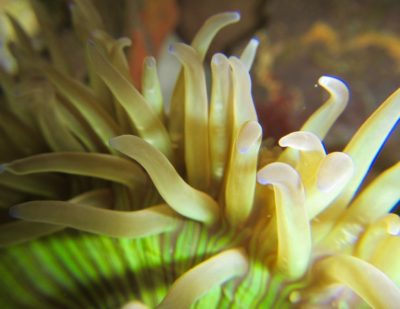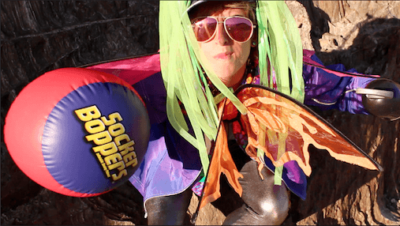
Hi there! It’s me, your local friendly Mantis Shrimp, also known as the Stomatopod. I’m guest blogging for CIMI this week to set a few things straight. First of all, I’m not actually particularly friendly. I have a mean reputation for dismembering my prey – namely any octopus, snail, fish, or human thumb that comes my way – with a powerful one-two punch from my giant club claw or a hairy spear appendage, followed by a shockwave of boiling water that’ll stun you even if I miss. But I digress. My 450 family members live all over the Pacific and Indian oceans, in shallow, tropical waters. But we’re a little obscure, since, you know, living in the shadows of deep hidden rock crevices you’ll never dare to investigate, so I figured it’s time you humans saw the world through my eyes.
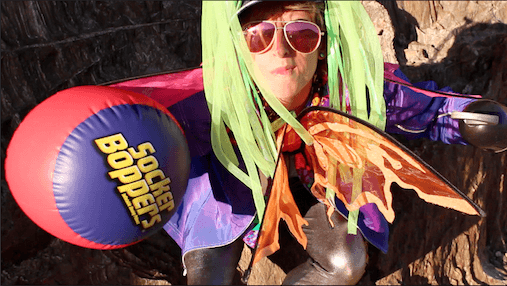
 Speaking of eyes, I have the most developed visual system yet discovered in the animal kingdom. In your eyes, you’ve got two different types of cells that help you see: rods and cones. Rods are located around the edges of your retina, and help you see contrast, brightness, black and white, and movement. Cones, on the other hand, help you see color.
Speaking of eyes, I have the most developed visual system yet discovered in the animal kingdom. In your eyes, you’ve got two different types of cells that help you see: rods and cones. Rods are located around the edges of your retina, and help you see contrast, brightness, black and white, and movement. Cones, on the other hand, help you see color.
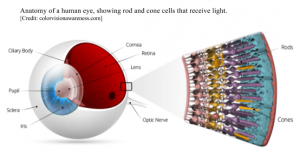 You measly humans have three types of cone cells in your retina: red-sensitive cone cells, green-sensitive, and blue-sensitive. That’s one step up from dogs and cats, I suppose, who lack the red cone and therefore can only see shades of blue and green. Your red-sensitive cone allows you to see not only red, but orange, yellow, and purple. Butterflies have five types of cones in their complex compound eyes, affording them almost the best color vision out there. This allows them to see into the ultraviolet spectrum, and recognize which plants to pollenate.
You measly humans have three types of cone cells in your retina: red-sensitive cone cells, green-sensitive, and blue-sensitive. That’s one step up from dogs and cats, I suppose, who lack the red cone and therefore can only see shades of blue and green. Your red-sensitive cone allows you to see not only red, but orange, yellow, and purple. Butterflies have five types of cones in their complex compound eyes, affording them almost the best color vision out there. This allows them to see into the ultraviolet spectrum, and recognize which plants to pollenate.
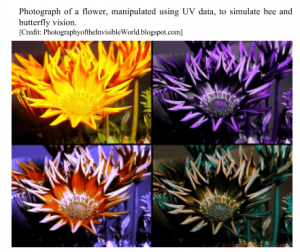 I don’t like to brag, but I’ve got 16 cones. 16! That means, to imagine seeing the world the way I see it, you’ve got to imagine a color you’ve never seen before, don’t have a name for, and can’t comprehend. Then imagine all the colors derived from that color. Then do that again. Then do that ten more times. Yeah. Some scientists theorize that my excellent color vision is for communication with my fellow mantises. That definitely plays a role, because I actively fluoresce, and that’s how we signal to each other that it’s time to choose a mate. Maybe I also need acute vision to have extremely accurate depth perception, when it’s time to aim to smash my dinner to smithereens… which is, you know, always.
I don’t like to brag, but I’ve got 16 cones. 16! That means, to imagine seeing the world the way I see it, you’ve got to imagine a color you’ve never seen before, don’t have a name for, and can’t comprehend. Then imagine all the colors derived from that color. Then do that again. Then do that ten more times. Yeah. Some scientists theorize that my excellent color vision is for communication with my fellow mantises. That definitely plays a role, because I actively fluoresce, and that’s how we signal to each other that it’s time to choose a mate. Maybe I also need acute vision to have extremely accurate depth perception, when it’s time to aim to smash my dinner to smithereens… which is, you know, always.
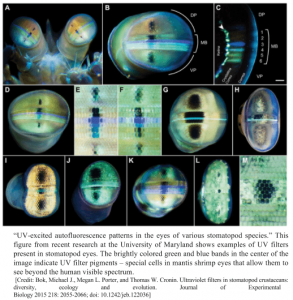 Bottom line is, your human science will never fully understand my glorious eyeballs.
Bottom line is, your human science will never fully understand my glorious eyeballs.
We mantis shrimp come in a couple of different models: smashers and spearers, so to speak. Some of us have long, spiky appendages that ensnare and impale our prey, while others have a giant blunt “club” claw that packs a punch like no other. I strike with a force that is approximately 100 times my own body weight. If you could accelerate your arm at ONE TENTH of that speed, you could throw a baseball off the planet.
 What with my club hand, I’m not the best at writing blogs. I’m better at rapping. Check out my debut.
What with my club hand, I’m not the best at writing blogs. I’m better at rapping. Check out my debut.
P.S.
- To watch me punch stuff in slow-motion, check out https://www.youtube.com/watch?v=ti2Uoc1RXuQ
- For more cool photography techniques exploring animal vision, check out http://photographyoftheinvisibleworld.blogspot.com/
- To read about my famous peepers in the Journal of Experimental Biology, check out http://jeb.biologists.org/content/218/13/2055
- If you like comics, check out the one that made me famous: http://theoatmeal.com/comics/mantis_shrimp *
*You can also buy a T-shirt with my face on it, so, that’s pretty awesome.

